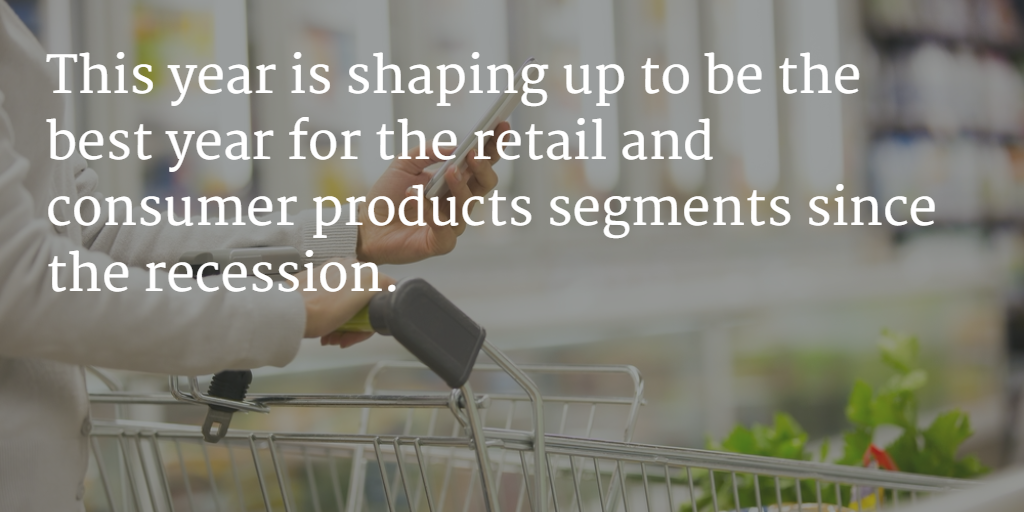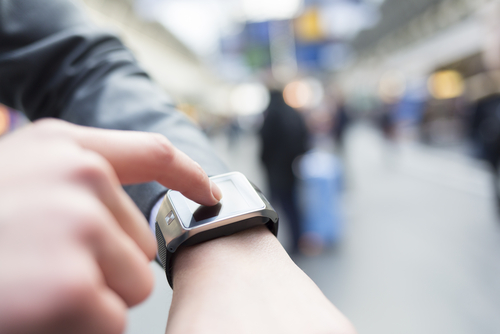 This year is shaping up to be the best year for the retail and consumer products segments since the recession. Moody’s recently upgraded its retail forecast to a 5.3% growth rate in 2016, almost double the growth rate in the last few years, with particularly strong growth expected in home improvement and grocery. Although apparel sales are flat, consumers are spending instead on vacations and dining out. eCommerce will continue to outperform broad retail, and with it all elements of digital marketing, content, and creative.
This year is shaping up to be the best year for the retail and consumer products segments since the recession. Moody’s recently upgraded its retail forecast to a 5.3% growth rate in 2016, almost double the growth rate in the last few years, with particularly strong growth expected in home improvement and grocery. Although apparel sales are flat, consumers are spending instead on vacations and dining out. eCommerce will continue to outperform broad retail, and with it all elements of digital marketing, content, and creative.
Trends to watch out for:
Customer Experience
I n 2015, webrooming (researching products online and then visiting a store to make a purchase) became more common than showrooming (visiting a store or stores in order to examine a product before buying it online) as omni-channel retailing became firmly established as table stakes. There are still areas to improve, particularly in inventory management and demand planning, but it’s no longer about online vs. in-store. Omni-channel strategies are giving way to customer experience strategies. These strategies start with how the customer experiences every step of the shopping journey, from awareness and selection to buying and using. Understanding this journey is key to delivering the right combination of in-store and digital experiences along the way.
n 2015, webrooming (researching products online and then visiting a store to make a purchase) became more common than showrooming (visiting a store or stores in order to examine a product before buying it online) as omni-channel retailing became firmly established as table stakes. There are still areas to improve, particularly in inventory management and demand planning, but it’s no longer about online vs. in-store. Omni-channel strategies are giving way to customer experience strategies. These strategies start with how the customer experiences every step of the shopping journey, from awareness and selection to buying and using. Understanding this journey is key to delivering the right combination of in-store and digital experiences along the way.
Personalization
 A sharp focus on customer experience is also driving the need for greater personalization in brand interactions. Customers expect more relevancy in their interactions, from a simple greeting to a deep understanding of their buying history, and offers that are focused on the right needs, at the right time, and at the right place to gain and hold their attention. A richer digital experience means that there are more opportunities to both learn about consumer behavior and respond to them with personalized offers and interactions.
A sharp focus on customer experience is also driving the need for greater personalization in brand interactions. Customers expect more relevancy in their interactions, from a simple greeting to a deep understanding of their buying history, and offers that are focused on the right needs, at the right time, and at the right place to gain and hold their attention. A richer digital experience means that there are more opportunities to both learn about consumer behavior and respond to them with personalized offers and interactions.
Connected Products and the Internet of Things
 The same technology infrastructure that has fostered the mobile revolution is rapidly maturing equally connected products as the Internet of Things becomes ubiquitous. From smart microwaves and light bulbs, to connected ice machines and running shoes, there isn’t a single product category that doesn’t have some connected strategy associated with it. Look for new angles on the IoT including the “device mesh” and brands that will offer an “ambient user experience.” The management, security, integration and other technologies behind the scenes will be the basis for delivering new customer experiences.
The same technology infrastructure that has fostered the mobile revolution is rapidly maturing equally connected products as the Internet of Things becomes ubiquitous. From smart microwaves and light bulbs, to connected ice machines and running shoes, there isn’t a single product category that doesn’t have some connected strategy associated with it. Look for new angles on the IoT including the “device mesh” and brands that will offer an “ambient user experience.” The management, security, integration and other technologies behind the scenes will be the basis for delivering new customer experiences.
The Values Shopper
 We will continue to see a rapid increase in consumer preferences towards products and retailers that share their personal values, particularly in food, health, and beauty. Products and brands will promote wellness, nutrition, and a healthier and more organic lifestyle. Authenticity and locality will be more prevalent features. Products and brands will work to develop more transparency and trust, and prove that their companies are responsible and sustainable stewards of the environment. This will be challenging for big brands like General Mills and Volkswagen, with inherent institutional distrust.
We will continue to see a rapid increase in consumer preferences towards products and retailers that share their personal values, particularly in food, health, and beauty. Products and brands will promote wellness, nutrition, and a healthier and more organic lifestyle. Authenticity and locality will be more prevalent features. Products and brands will work to develop more transparency and trust, and prove that their companies are responsible and sustainable stewards of the environment. This will be challenging for big brands like General Mills and Volkswagen, with inherent institutional distrust.
Fragmentation
 The traditional era of simple products, advertised through print and broadcast, and sold through a single format retailer are well behind us. The fragmentation of consumer segments, media channels, product options, and sales channels will continue to multiply and fragment, making it more challenging for brands and retailers to keep track and capture consumers. Household structures have radically changed from the traditional nuclear family. Television viewing is down and consumers are routinely interacting through as many as seven connected devices. Consumers trust a stranger’s online review over a billboard. Products are catering to narrower preferences or being custom-made to individual orders. Consumers shop in one format and buy in another. Brands and retailers must be more sophisticated than ever to respond to these demands.
The traditional era of simple products, advertised through print and broadcast, and sold through a single format retailer are well behind us. The fragmentation of consumer segments, media channels, product options, and sales channels will continue to multiply and fragment, making it more challenging for brands and retailers to keep track and capture consumers. Household structures have radically changed from the traditional nuclear family. Television viewing is down and consumers are routinely interacting through as many as seven connected devices. Consumers trust a stranger’s online review over a billboard. Products are catering to narrower preferences or being custom-made to individual orders. Consumers shop in one format and buy in another. Brands and retailers must be more sophisticated than ever to respond to these demands.
The Empowered Associate
 Online commerce grew at an aggressive 14% in 2015, but still only accounts for less than 10% of all retail sales. The omni-channel push over the last few years has only reinforced the value of physical stores for consumers when their experience is balanced with digital options. While self-service digital options for consumers are growing, there is even greater pressure on in-store associates to be a strong source of information and service to the in-store shopper. Associates must be at least as digitally equipped and informed as their customers with access to real-time product and store information, deals and promotions, and to be able to respond to any conceivable customer service request.
Online commerce grew at an aggressive 14% in 2015, but still only accounts for less than 10% of all retail sales. The omni-channel push over the last few years has only reinforced the value of physical stores for consumers when their experience is balanced with digital options. While self-service digital options for consumers are growing, there is even greater pressure on in-store associates to be a strong source of information and service to the in-store shopper. Associates must be at least as digitally equipped and informed as their customers with access to real-time product and store information, deals and promotions, and to be able to respond to any conceivable customer service request.
